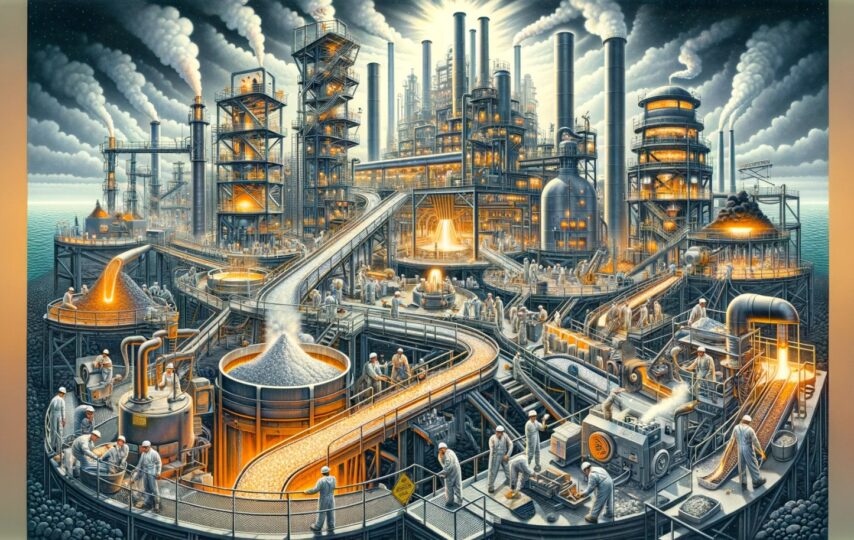Due to the high demand for this critical mineral, tungsten production is gaining significance in a number of key industries. Because of its unmatched strength and adaptability, as well as other advantageous properties, tungsten is at the heart of many industrial operations. We dig into the intricate world of tungsten production in this comprehensive examination, unraveling its journey from raw ore to the alloys that fuel innovation across many different sectors.
- Extraction of Tungsten:
Tungsten, which occurs naturally in minerals such as wolframite and scheelite, must be extracted meticulously before tungsten production commences. Miners use technology and determination to harvest tungsten ore from the earth’s depths. This first stage of the tungsten production process establishes the tone for the entire journey.
- Refining the Precious Yield:
After extraction, tungsten ore is refined to remove impurities and unlock its full potential. Various tungsten production processes, including as froth flotation and gravity separation, are used, each contributing to the transformation of raw tungsten ore into a more valuable product.
- The Smelting Crucible:
Smelting is a vital step in the tungsten production process that involves heating the refined tungsten concentrate with carbon. This procedure converts the concentrate to tungsten oxide, clearing the path for the oxide to be reduced to pure tungsten metal.
- Tungsten Ingot Formation:
The reduced tungsten oxide is next crushed into tungsten metal powder, laying the groundwork for the formation of tungsten ingots. This phase uses heat and pressure, similar to natural geological processes, to produce tungsten in a pliable form that may be sculpted for specific applications.
- Tungsten Alloys:
Tungsten Production rarely stands alone it frequently collaborates with other metals to make powerful alloys. The alloying process improves the already amazing qualities of tungsten, resulting in materials with improved strength, hardness, and resilience. Alloys, particularly tungsten carbide and ferrotungsten, have transformed industries ranging from mining to manufacturing.
Tungsten Metals Group owns and operates the largest ferrotungsten factory outside of China with an impressive output capacity of 4,000 tonnes annually. Explore Their production processes at their ferrotungsten factory in Vietnam to learn more about tungsten production and how they convert raw tungsten feedstock into ferroalloys.
Global Perspectives on Tungsten Production:
The panorama of tungsten production around the world is driven by geographical variations, technology discrepancies, and specific labour practices. This global investigation provides a thorough picture of how various locations contribute to the rich fabric of tungsten manufacturing.
- Dominance of Asia: Asia is emerging as a tungsten production powerhouse, with China at the lead. China dominates both production and exports by leveraging superior mining methods and substantial reserves. However, the sector has a number of obstacles, including environmental issues and the necessity for long-term practises.
- Europe’s Legacy: The tungsten production legacy in Europe, particularly in Austria and Portugal, is inextricably linked to historical mining activity. These regions’ technological achievements have modernised extraction and refining methods. While European tungsten production is no longer at its peak, it continues to play an important role in global supply chains.
- The Contribution of the Americas: North and South America also make substantial contributions to the global tungsten landscape. Countries such as Canada and the United States have significant tungsten reserves and use innovative technologies to assure efficiency and sustainability. The Americas, with their booming sectors, play an important role in the evolving global tungsten story.
- Australia’s Growing Influence: Australia is emerging as a significant player in the global tungsten market in the Southern Hemisphere. Australia contributes significantly to global tungsten supply due to its large mineral reserves and commitment to cutting-edge mining technology. The country’s strict environmental legislation, as well as its emphasis on sustainable practices, serve as a model for responsible tungsten production.
- African Potential: Africa, with its enormous unexplored mineral resources, has significant tungsten potential. While the continent’s contribution is now less than that of other regions, continuous explorations and investments point to a potential rise in prominence.
A comparison of tungsten production in these regions reveals disparities in technology, environmental legislation, and labour practices. China’s supremacy extends beyond production to technical innovation, whilst Europe’s emphasis is on sustainable practices. The Americas strike a mix between efficiency and environmentally sensitive measures, Australia establishes norms for ethical production, and Africa’s position is primed to grow. Understanding these worldwide viewpoints is critical for stakeholders in the sector, politicians, and environmentally conscious consumers. Stakeholders may foster collaboration, discuss best practices, and work towards a globally harmonised tungsten industry by appreciating the many approaches to tungsten production.
Sustainability in Tungsten Production:
In today’s world, the desire for sustainability has grown inextricably linked to industrial processes, and tungsten production is no different. Initiatives to reduce the environmental impact of tungsten extraction and refinement are gaining traction. Regulations are changing, and technological advancements are paving the door for more environmentally friendly practices.
Exploration of eco-friendly mining processes that prioritise minimising ecological disturbances is one significant component of sustainable tungsten production. Efforts to improve energy efficiency in the refining and smelting stages also contribute to a lower carbon footprint.
The recycling of tungsten resources is also increasing in many industries. Recycling not only conserves valuable resources but also reduces waste, aligning tungsten manufacturing with the ideals of the circular economy. This emphasis on recycling demonstrates the tungsten industry’s commitment to responsible resource management. Demand for sustainably derived materials is increasing as customers choose ecologically conscientious practices. Tungsten producers are responding by incorporating environmentally friendly technologies and practices into their manufacturing processes. Because of its alignment with global sustainability goals, tungsten, a metal famous with strength and tenacity, is also a torchbearer for ecologically responsible industrial practices.
The tungsten manufacturing process, a symphony of geological wonders and human creativity, exemplifies the journey from the depths of the earth to the cutting edge of technological innovation. We see not just the history of a critical metal but the evolving story of an industry that continues to affect our world as we travel through extraction, refinement, smelting, shaping, alloying, and global perspectives. With sustainability as its guiding star, tungsten production is set for a future in which strength and environmental awareness coexist.








